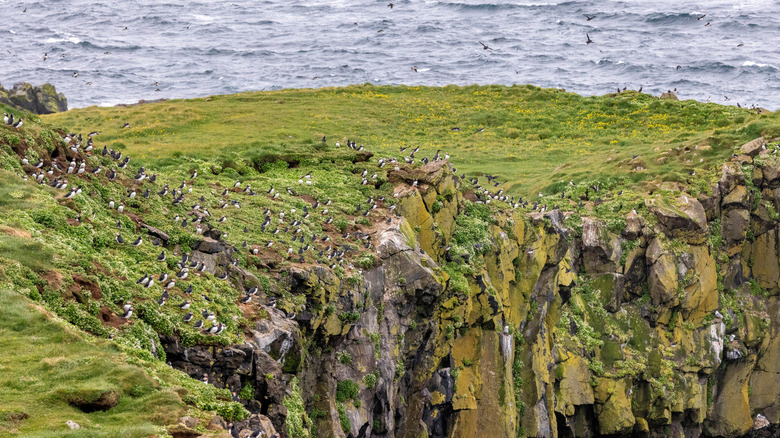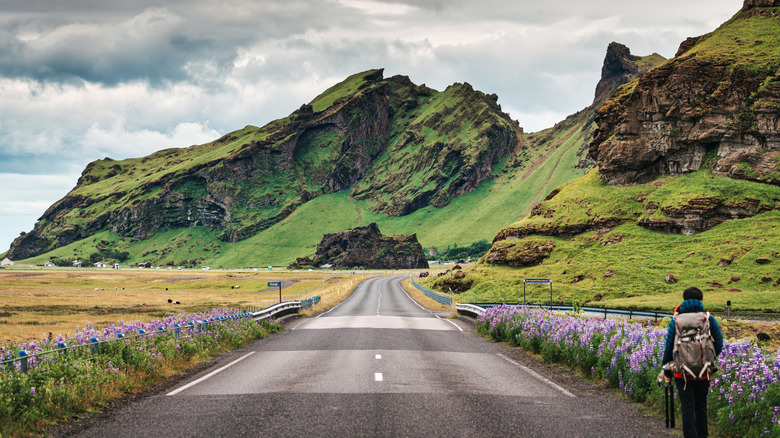Europe's Coolest Vacation Destination To Escape The Heat Is A Breathtaking Country
Summer is often the best time of year to travel and explore. Unfortunately, in many parts of the world, it is also the hottest. When planning summer trips, many travelers look for destinations that offer a break from the heat. That is where "coolcations" come into play. As the name suggests, these are vacation spots around the world where you can wear your favorite fall and winter outfits without melting, even in summer. According to Inghams Walking (via Express U.K.), there are several coolcations worth exploring. Topping their list of European destinations is Iceland, particularly Akureyri.
Iceland is a cool destination year-round. Even in the height of summer, the country's northern region rarely sees 60 degrees Fahrenheit. It also does not get painfully cold, as the average low temperature stays above 20 degrees Fahrenheit.
Visiting Iceland in summer offers plenty to do and explore. The nearly endless daylight hours make it easy to spend full days outdoors. Hiking is a must, as the mild temperatures lower the risk of overheating (though it's sitll important to bring plenty of water). TheLaugavegur Trail, a long and iconic trail widely recognized as one of the best hikes in Europe, is a great option during the season. The country's highlands are also only open during the summer, when the snow is mostly gone and the roads are clear, giving travelers the opportunity to see glaciers and volcanoes while exploring.
What to do when visiting Iceland in the summer
Inghams Walking didn't just list Iceland as the best coolcation but highlighted a specific place within the country: Akureyri, often referred to as the capital of the north. It doesn't have a terribly large population — only 18,500 people or so, according to Visit Akureyri — but it has plenty to do to keep you entertained for an entire vacation and leave you eager to come back for more. Attractions include botanical gardens, museums, wildlife watching, and hikes to beautiful waterfalls. Iceland's second-largest city is also an ethereal and overlooked gem with fewer crowds than Reykjavik, which makes it the perfect spot for travelers hoping to avoid the summer rush.
But while Akureyri topped the list, there are plenty of other destinations in Iceland you shouldn't miss out on during your vacation. For example, on cooler days, there is nothing better than taking a dip in a Viti crater, where the water sits in the high 70s. While this may feel a little cool at first, after a day spent outside in the typical Icelandic temperatures, it can manage to feel pretty warm. Skaftafell National Park is another great summer destination with its mountainous area filled with waterfalls and wildflowers.
If you like wildlife, you can also go and see puffins along the Westfjords and Northern Iceland. You can hike to see them, or take boat tours. In fact, a tour to Grimsey Island offers the chance to catch sight of both whales and puffins, making it a favorite for nature lovers.
Take a road trip or visit during a different season to see more of Iceland
Getting to Iceland is fairly easy. Most travelers arrive by air, typically landing at Keflavík International Airport. It's located in the southwest of the country, so if you want to explore northern destinations like Akureyri, then you still have a bit of a journey ahead when you land. The drive takes about 5 hours, though you can also take public transportation if you don't mind doubling your time. Driving gives you great chance to explore part — or all — of Iceland's Ring Road, which is an 820-mile route that connects many of the country's major destinations. Along the way, you can witness the beautiful nature Iceland is known for, including fjords, mountains, waterfalls, and more. Of course, because of the risk of heavy snowfall during much of the year, the route is safest to travel in the summer.
Although summer is often the most popular time to visit Iceland, it's a country you can travel to during any part of the year. At the peak of summer, you get daylight for basically 24 hours. This is fantastic for hikers and outdoor explorers, but unfortunately, it can be a bit of a downside, too. If you want a chance to see the northern lights, go skiing, relax under the stars, or enjoy the hot springs, spring, fall, or winter may be better seasons to visit. Ultimately, the best time to explore Iceland is up to you.


